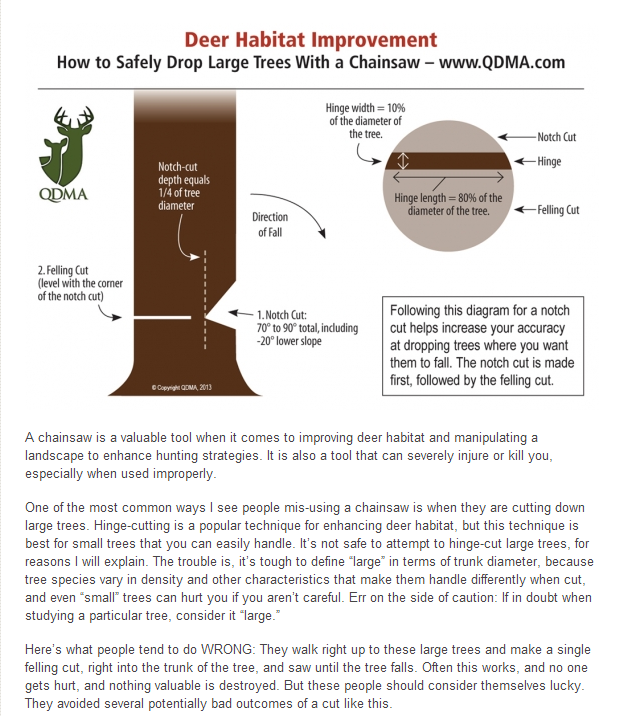In many situations, felling a tree is the only way to prevent a potential hazard from happening in a neighborhood. Sometimes, though, felling a tree is, itself, the hazard.

The Internet is rife with tree felling blunders that result in more than just the tree falling down. Most of the fellers shown on internet videos do the cutting themselves, relying on either an axe or a chainsaw, but rarely both. That’s exactly the kind of mistake the Quality Deer Management Association (QDMA), based in Bogart, GA, stresses, in an article on its website.
“Here’s what people tend to do WRONG: They walk right up to these large trees and make a single felling cut, right into the trunk of the tree, and saw until the tree falls. Often this works, and no one gets hurt, and nothing valuable is destroyed. But these people should consider themselves lucky. They avoided several potentially bad outcomes of a cut like this.”
The observation may be coming from deer management experts, but deer are just as prone to falling trees as everyone or everything else. In California, Palo Alto tree care professionals, such as Bay Area Tree Specialists, apply different methods to safely fell a tree. One of these methods, which is designed to work with forest-sized trees, is likewise recommended by the QDMA.
Establishing Control
Unless the tree is leaning toward one direction, it’s impossible to tell where the tree would fall. So, in this method, it’s important to cut a chunk on one side before slicing it with a chainsaw on the other side.
The first step in felling control is creating a notch cut. According to the Occupational Safety and Health Administration (OSHA), the conventional notch cut has a top cut angled at 45 degrees and a flat bottom cut. For felling big trees, however, fellers need to do an open-faced notch cut; the top cut angled at 70 to 90 degrees and the bottom cut at 20 degrees.
After notch-cutting the tree to 25 percent of its diameter, the feller can out the chainsaw and do a felling cut. There’s no need to cut the tree all the way to the point of the notch cut; OSHA specifies a hinge length of around 80 percent of the tree’s diameter. The width of the hinge, also according to OSHA standards, must be 10 percent of the tree’s diameter.
From there, gravity will take its course.
People who have zero knowledge of felling techniques should better call a San Jose tree pruning service like Bay Area Tree Specialists. Professional tree pruning companies may have methods that vary from the conventional, but the important thing is, they get the job done safely.
(Source: “How to Safely Drop Large Trees with a Chainsaw,” QDMA)

